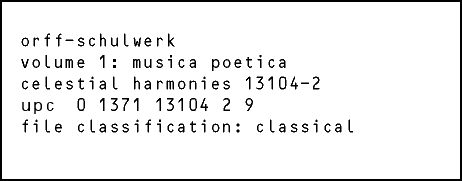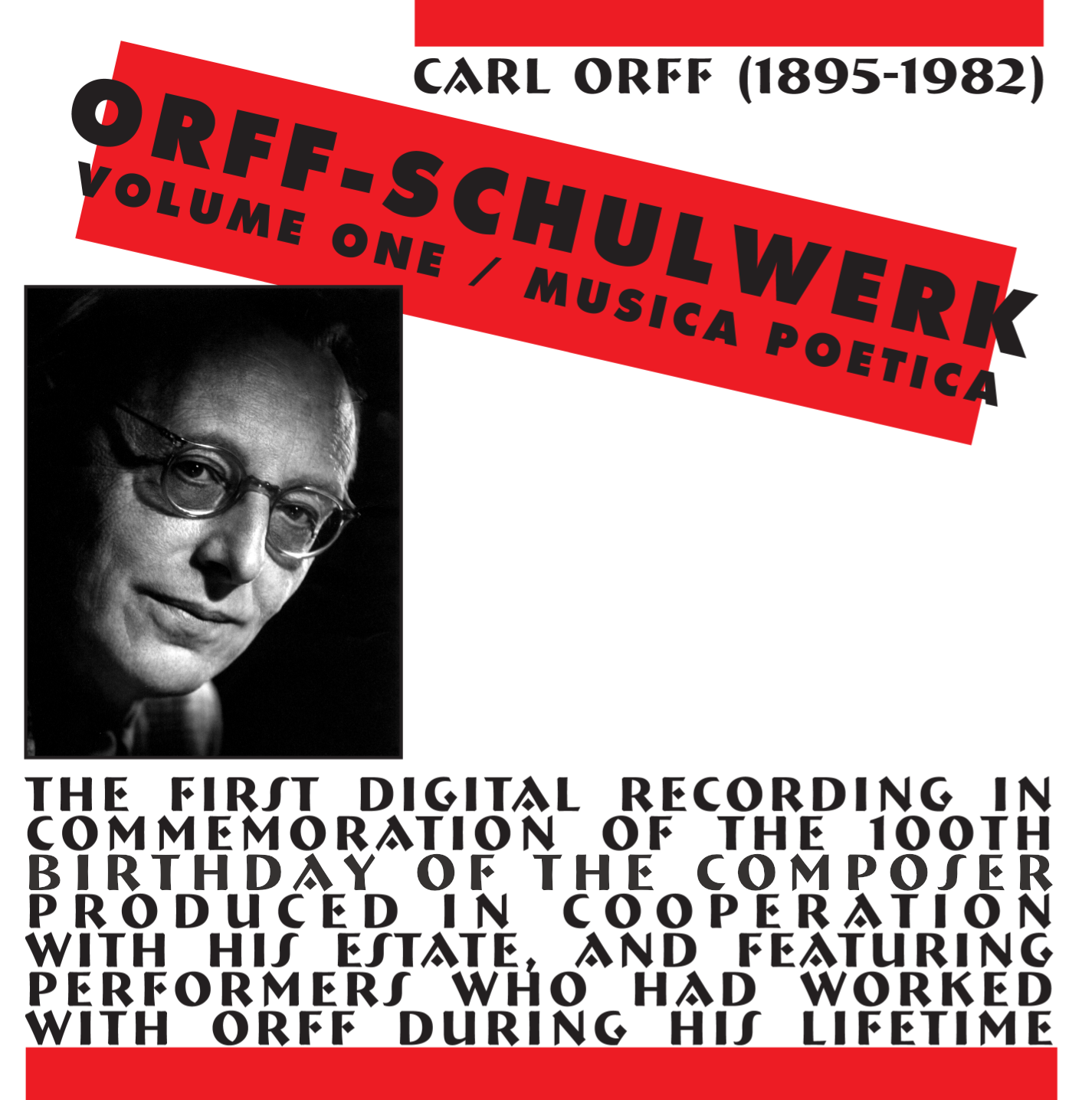 
* featured in Finding Forrester
starring Sean Connery, Visa Lap commercial (.mov)
Weltberühmt wurde er durch seine „Carmina Burana“,
eines der meistgespielten Werke klassischer Musik überhaupt.
Noch wirksamer war jedoch eine Fülle von kleinen Kompositionen
zu pädagogischen Zwecken. Fast jede deutsche Schule hat seit
einem halben Jahrhundert ein „Orff-Instrumentarium“. Schlaginstrumente
wie Xylophone, Tamburin und Triangel repräsentieren dabei einen
für die europäische Klassik ungewöhnlichen, für
Orff jedoch typischen Ansatz: die körperorientierte Rhythmik
(„Am Anfang war die Trommel“). Kinder (wie auch Patienten
der Musiktherapie) lernen Rhythmusgefühl als musikalische Basis,
Koordination aller körperlich-geistigen Bewegungen, erfahren
Erdung. Doch das hier vorgestellte (zum großen Teil in Zusammenarbeit
mit Gunhild Keetman entstandene) Orff-Schulwerk umfasst das ganze
Spektrum der Musik. Es ist Orffs Lebenswerk und wahres Vermächtnis:
Anregung für jeden, selbst zu musizieren oder zumindest aktiv
zu hören. Die erste digitale Aufnahme zu Orffs 100. Geburtstag
mit Künstlern, die noch bei Orff selbst studierten.
"Je wesentlicher, vereinfachter die Aussage, desto unmittelbarer
und stärker ist die Wirkung" (Carl Orff.). 42 kurze Kompositionen
von Carl Orff und Gunhild Keetman, Stücke für Sopran,
Violine und Cello, Klavier, Blockflöten, Schlaginstrumente
(Xylophon, Trommel, Zimbel, Triangel etc). Ein Querschnitt des Schulwerks.
Jedes Stück hat enorme Dynamik, Bewegungspotenz, ist eine Geste,
ein Tanz. Voller Überraschungen, höchst inspirierend.
the project
Coinciding with the 100th anniversary of Carl Orff's
birth, Orff-Schulwerk Volume 1: Musica Poetica is the first
release of a five–volume collection in celebration of the composer's
lifetime of monumental work. Many of the works included in this series
have been unavailable on recording for decades. Furthermore, this
collection marks an unprecedented addition to the worldwide music
catalogue: it is the first comprehensive collection of the Orff-Schulwerk
to be digitally recorded, and has been produced with the cooperation
of the composer's widow, his daughter Godela Orff (who also performs
on this recording), and the artistic executor of his estate, Wilfried
Hiller.
Musica Poetica presents a cross–section
of the great pedagogical work, Orff-Schulwerk. As prototypes
for experimentation, the pieces of the Schulwerk have an
openness to creativity which invites the performer to have fun while
creating music. Orff believed that by speaking to a child's most natural
musical instincts to clap or sing or keep a beat, these pieces would
awaken the musical talent which lies in everyone.
In addition to hand–clapping and finger–snapping,
Orff incorporated rattles inspired by the Indonesian gamelan tradition
and by African musical cultures. Drawing on the knowledge of his friend
Kurt Sachs and instrument-maker Karl Maendler, Orff developed his
own set of instruments for the Schulwerk, including all sizes
of xylophones, glockenspiels, kettledrums, tambourines, sleigh–bells
and triangles.
Although the pieces of Orff-Schulwerk are
prototypical in nature, the work reaches far beyond simple pedagogical
exercise. The quality of movement, and the same scenic and pictorial
elements which would later influence Orff's great stage works, are
apparent in even the shortest pieces of the Schulwerk. Schulwerk
runs the gamut from the fleeting, changing miniature to grand, ecstatic
movement music. It encompasses parade music, folk, dance, children's
songs and musical fairy tales. This collection offers a refreshing
approach to music, for young and old alike.
the artists
The pieces recorded in Musica Poetica
are performed in the playful and creative style intended
by the composer. Artistic director of the recording, Wilfried Hiller,
has conscientiously worked in the spirit of his former teacher Orff.
Authenticity is further lent by the Karl Peinkofer Percussion Ensemble
whose leader, Karl Peinkofer, performed many of Orff's works under
the direction of the composer himself.
This recording features Orff's daughter, Godela Orff,
performing parts for spoken voice. Martina Koppelstetter sings mezzo
soprano, Carolin Widmann plays the violin, Sabina Lehrmann the cello,
and recorder parts are performed by Markus Zahnhausen.
| |
VIER STÜCKE FÜR XYLOPHON (Gunild
Keetman) |
|
| 1 |
Gassenhauer nach Hans Neusiedler (1536) für
Sopran-, Altxylophon, Castagnetten, |
2'57" |
| |
kleine Trommel, Schellentrommel und Pauken, Musik
für Kinder III, Nr. 15 (1952) * |
|
| 2 |
Allegro für Sopran-, Altxylophon, Schellentrommel
und kleine Trommel ohne Schnarrsaite |
1'00" |
| |
Spielbuch für Xylophon II Nr. 15 (1966) |
|
| 3 |
Allegretto für Sopran-, Altxylophon, Maracas,
Schellentrommel und Tom-Toms |
1'16" |
| |
Spielbuch für Xylophon III Nr. 24(1966) |
|
| 4 |
Sempre rubato für Sopran- und Altxylophon,
|
1'31" |
| |
Spielbuch für Xylophon III Nr. 16 (1966)
|
|
| |
|
|
| |
FÜNF KLEINE KANONS (Gunild Keetman
aus "Stücke für Flöte und Trommel",
1956) |
|
| 5 |
Erster Kanon für Sopran-, Tenorblockflöte
und Handtrommel |
1'00" |
| 6 |
Zweiter Kanon für Sopran-, Tenorblockflöte
und Templeblocks |
0'42" |
| 7 |
Dritter Kanon für Renaissance-Blockflöte
in G und zwei Tom-Toms |
0'45" |
| 8 |
Vierter Kanon für Sopranino, Altblockflöte
und kleine Trommel |
1'26" |
| 9 |
Fünfer Kanon für Tenorblockflöte
und zwei Tom-Toms |
1'05" |
| |
|
|
| |
VIER TANZSTÜCKE (Carl Orff) |
|
| 10 |
Tanz (eingerichtet von Wilfried Hiller) für
Violine und Violoncello |
1'45" |
| |
Klavier Übung I, Kleines Spielbuch, Nr. 8,
9, 10 (1966) |
|
| 11 |
Hirtentanz (eingerichtet con Wilfried Hiller)
für Violine und Violoncello |
0'54" |
| |
Klavier-Übung I, Nr. 11(1933), Geigen-Übung
1, Nr. 13 (1933) |
|
| 12 |
Tanz für Tenorblockflöte, Violine und
Violincello und Schellen |
0'53" |
| |
Rhythmisch-melodische Übung, Nr. 122 (1931) |
|
| 13 |
Tanz für Violine Solo, Geigen-Übung
1, Nr. 40 (1933) |
0'40" |
| |
|
|
| |
LIEDER UND SPIELSTÜCKE (Carl Orff)
|
|
| 14 |
Andante für Tenorblockflöte, Violine
und Violoncello und Triangel |
1'32" |
| |
Rhythmisch-melodische Übung, Nr. 70 (1931) |
|
| 15 |
Con moto für Sopranblockflöte, Violine
und Violoncello und Schellen |
1'04" |
| |
Musik für Kinder II, Nr. 12 (1951) |
|
| 16 |
Heia Popeia für Mezzosopran, Sopranblockflöte,
Glockenspiel, Violine und Violoncello |
0'53" |
| |
Musik für Kinder I, Nr. 27 (1950) |
|
| 17 |
Rondo (eingerichtet con Wilfried Hiller) für
Sopranblockflöte, Violin, Violoncello, |
2'34" |
| |
Templeblocks und Maracas |
|
| |
Musik für Kinder I, Nr. 22 und 37 (1950) |
|
| 18 |
Tun ma gehn, Rösserl bschlagn für Mezzosopran
und Klatsch-Chor |
0'49" |
| |
Musik für Kinder I, Nr. 1 (1950) |
|
| |
|
|
| |
DREI STÜCKE FÜR FLÖTE UND SCHLAGZEUG (Gunild
Keetman) |
|
| |
(aus: Stücke für Flöte und Trommel, 1956) |
|
| 19 |
Ruhig für Renaissanceblockflöte in G und Schellentrommel,
Nr. 7 |
1'28" |
| 20 |
Lebhaft für Sopranblockflöte und Bongos Nr. 14 |
0'32" |
| 21 |
Ruhig fließend für Sopran-, Tenorblockflöte, Zimbeln
und Triangel Nr. 15 |
2'11" |
| |
|
|
| |
LIEDER UND TÄNZE (Carl Orff) |
|
| 22 |
Schwalbenlied für Mezzosopran, Tenorblockflöte,
Violine und Xylophon |
0'48" |
| |
Musik für Kinder IV, Nr. 4 (1953) |
|
| 23 |
In kleinstem Raum für Mezzosopran, Tenorblockflöte,
Glockenspiel, Violine und Violoncello |
2'13" |
| |
Musik für Kinder IV, Nr. 7 und 8 (1953) |
|
| 24 |
Tanz für Alt-, Tenorblockflöte, Violine, Violoncello
und Handtrommel |
2'09" |
| |
Rhythmisch-melodische Übung, Nr. 66 und 67 (1931)
|
2'21" |
| 25 |
Ruhiger Tanz für Altblockflöte, Violine, Violoncello
und Bongos |
|
| |
Rhythmisch-melodische Übung, Nr. 69 und 70 (1931)
|
|
| 26 |
Der Lirendreier für Mezzosopran, Violine, Violoncello
und Altxylophon |
1'22" |
| |
Musik für Kinder IV, Nr. 10 (1953), Geigen-Übung
I, Nr. 39 (1933) |
|
| 27 |
Ekstatischer Tanz (Gunild Keetman) für Klatsch-Chor,
Rasseln und Schlagwerk |
2'43" |
| |
Musik für Kinder V (1954) |
|
| |
|
|
| |
ZWEI TAKTWECHSELTÄNZE FÜR VIOLINE UND VIOLONCELLO
(Carl Orff) |
|
| 28 |
Tanz 1 |
1'57" |
| |
Klavier-Übung I, Nr. 18 (1933), Geigen-Übung I,
Nr. 34 (1933) |
|
| 29 |
Tanz 2 |
1'09" |
| |
Klavier-Übung I, Nr. 21 (1933), Geigen-Übung I,
Nr. 7 (1933) |
|
| |
|
|
| |
SIEBEN VOLKSTÄNZE (Carl Orff) |
|
| 30 |
Marmotte für Mezzosopran, Sopranblockflöte, Violine,
Violoncello und Schellentrommel |
0'37" |
| |
Musik für Kinder IV, Nr. 15 (1953) |
|
| 31 |
Tanz 1 für Violine und Violoncello |
1'09" |
| |
Klavier-Übung, Nr. 29 (1933) |
|
| 32 |
Tanz 2 für Violine und Violoncello |
0'28" |
| |
Rhythmisch-melodische Übung, Nr. 116 |
|
| 33 |
Tanz 3 für Violine und Violoncello |
1'18" |
| |
Geigen-Übung I, Anhang |
|
| 34 |
Tanz 4 für Violine solo |
0'32" |
| |
Geigen-Übung I, Nr. 30 |
|
| 35 |
Tanz 5 für Violine solo |
0'47" |
| |
Geigen-Übung I, Nr. 38 |
|
| 36 |
J’ai vu le loup für Mezzosopran, Sopranino, Violine,
Violoncello und Schellentrommel |
1'30" |
| |
Musik für Kinder IV, Nr. 14 (1953) |
|
| |
|
|
| |
MUSIK ZUR NACHT |
|
| 37 |
Melodie (Gunild Keetman) für Renaissance-Altblockflöte
in G und Handtrommel |
1'27" |
| |
Stücke für Flöte und Trommel, Nr. 20 (1956) |
|
| 38 |
Abendsegen (Carl Orff) für Mezzosopran und Glockenspiel |
0'42" |
| |
Musik für Kinder IV, Nr. 36 (1953) |
|
| 39 |
Wiegenlied (Carl Orff) für Mezzosopran, Tenorblockflöte,
Glockenspiel, Violine und Violoncello |
1'02" |
| |
Musik für Kinder II, Nr. 3 (1951) |
|
| 40 |
Siziliano (Carl Orff) für Violine und Violoncello |
1'28" |
| |
Klavier-Übung I, Nr. 7 (1933) |
|
| 41 |
Das Märchen von Klein-Flöhchen und Klein-Läuschen
(Carl Orff) |
5'57" |
| |
für Sprechstimme, Altxylophon, Holztrommel, Große
Trommel, Becken, |
|
| |
Becken, Triangel, Tam-Tam, Ratsche und Maracas |
|
| |
Musik für Kinder V, Nr. 1 (1954) |
|
| 42 |
Die arme Bettelfrau singt ihr Kind in Schlaf (Carl
Orff) |
4'26" |
| |
für Mezzosopran, Tenorblockflöte, Glockenspiel,
Violine und Violoncello |
|
| |
Musik für Kinder IV, Nr. 7 (Vor- und Nachspiel)
(1953), Musik für Kinder IV, Nr. 44 |
|
| |
|
|






